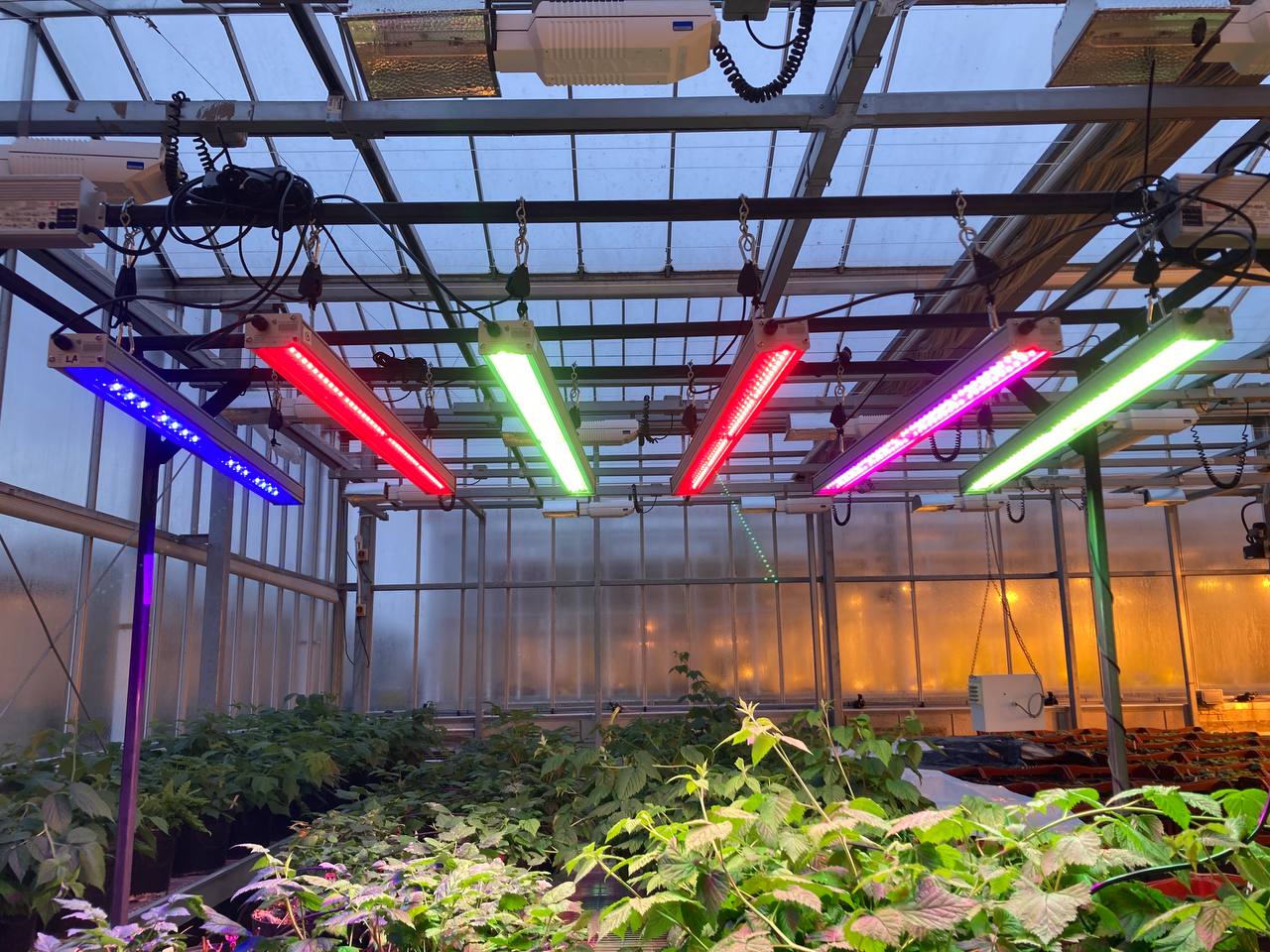


Today, plant lamps are predominantly based on LED technology. These lamps are very energy-efficient, durable, and allow for targeted spectral control, enabling them to optimally adapt the light to the needs of plants in different stages of development. This not only optimizes growth, flowering, and quality, but also saves energy.

Image source: Crocus Labs
Blue light in the range of approximately 400 to 500 nanometers promotes compact, vigorous plants, stimulates leaf growth and chlorophyll formation—especially in the early growth phase, such as in seedlings and young plants.
For those who want to know more: Blue light activates the two blue light receptors cryptochrome and phototropin. Cryptochromes control the circadian clock and inhibit elongation growth, promote compact plants, and influence leaf and chlorophyll formation. In young plant cultivation, this is used specifically to prevent yellowing and etiolation (stretching, excessive growth).
Phototropins, on the other hand, primarily control movement and orientation processes. They regulate phototropism, i. e., the directed growth of the plant toward the light source, open the stomata for improved gas exchange, and ensure that chloroplasts within the cells are optimally positioned for the incident light. They also respond to blue light, but activate a different signaling cascade than cryptochromes.
Green light in the range of 500 to 600 nanometers penetrates deeper into the leaf than blue or red light, thereby providing better light to the lower parts of the plant. In addition, reflected green light from neighboring leaves contributes to light yield. Therefore, a moderate amount of green light is important to improve overall light distribution in dense stands and increase overall photosynthetic efficiency.
The once widespread assumption that green light is virtually ineffective for plants is based on the strong absorption of blue and red light by chlorophyll. Recent research shows that green light penetrates deeper into the leaf tissue, where it reaches chloroplasts that would otherwise remain unused. White light (with a green component) therefore specifically supplements the photosynthetic potential.
Red light between 600 and 700 nanometers enhances photosynthesis, promotes growth, and encourages flowering and fruiting.
Far-red light, usually around 700 to 750 nanometers, specifically controls flowering and ripening and is often used at the end of the day to support these processes.
To explain this in more detail: phytochromes, the red and far-red light receptors, form a reversible system consisting of two conformations: Pr (phytochrome red) absorbs red (~660 nm), is converted to Pfr (phytochrome far red), which absorbs far red (~730 nm), and is then converted back to Pr. This R/FR system serves as a molecular light resonance switch. A high R/FR ratio signals favorable light conditions and can promote flowering. A low ratio—often found in shade—triggers elongation, for example, so that the plant grows toward the light. This system controls germination, leaf development, flowering times, and adaptations to the season.
Dynamic plant lamps now make it possible to flexibly adjust spectral components during operation. For example, you can use a lot of blue during the seedling phase, let red dominate during the vegetative phase, and use red and far-red specifically during the transition to flowering or ripening.
This dynamic light control is already being used today in vertical farms and indoor gardening systems, such as for microgreens and salads, in greenhouse operations for vegetables and herbs, in ornamental plant production and young plant cultivation, as well as in research and teaching at universities. Such spectral controls are particularly important for special crops such as aromatic plants or in countries where cannabis cultivation is legal.
The use of such targeted light recipes can significantly improve the yield, quality, and robustness of plants.
Here we show spectra from a dynamic plant lamp by Crocus Labs. This company develops advanced lighting systems with sensors and special LEDs to create an ideal lighting environment. The technology supports human biorhythms and enables precisely controlled horticulture. The company is supported by the European Innovation Council (EIC) Accelerator program and leading German venture capitalists.

The spectra were recorded using our new microspectrometer. This type of spectrometer is ideal for recording LED spectra: it provides high-resolution data that can be used to accurately detect narrow emission peaks. This allows individual LED wavelengths to be precisely identified and their intensity distribution to be accurately quantified—a great help in lamp development and spectral fine-tuning.
The dynamic SiriusX03 plant lamp from Crocus Labs uses LEDs in four different color channels to achieve the desired spectral distribution of light.
White LEDs provide a broad basic spectrum, which is generated by a phosphor layer, and simultaneously cover blue, green, and red tones. This is technically more efficient and economical than separate green or yellow LEDs, which would have to be controlled separately and are generally less efficient. To generate light in the blue, red, and far-red spectral ranges, corresponding LEDs with a narrower half-width are used.
In order to obtain simple assistance in achieving the best possible spectral setting for the lighting in practical operation, the components contained in the light spectrum can be divided into four wavelength ranges that are particularly relevant for plant physiology:
The measured spectra are then evaluated mathematically and the resulting values are combined into normalized integral values. In this way, the relative contributions of these four channels can be compared quickly and intuitively.
It is important to note that the specified wavelength ranges and the integral values calculated from them are not a scientific standard and do not claim to be exact physiological effect curves. They have been deliberately simplified to enable quick orientation in practical operation.
 Would you like to replicate the experiment—in your laboratory or teaching environment? Feel free to contact us—we will assist you with planning, setup, calibration, and selecting the right components. Eureca offers advice based on many years of expertise in optoelectronics, optics and spectroscopy—from DIY setups to OEM solutions. Feedback is expressly welcome: Please share your experiences, results, or suggestions for improvement with us.
Would you like to replicate the experiment—in your laboratory or teaching environment? Feel free to contact us—we will assist you with planning, setup, calibration, and selecting the right components. Eureca offers advice based on many years of expertise in optoelectronics, optics and spectroscopy—from DIY setups to OEM solutions. Feedback is expressly welcome: Please share your experiences, results, or suggestions for improvement with us.
Here you can easily ask a question or inquiry about our products:
Last update: 2025-31-10
